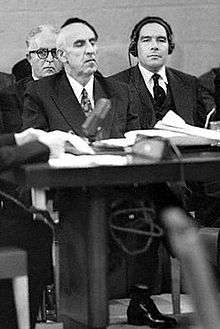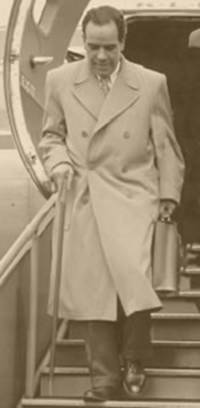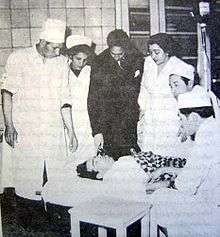Hossein Fatemi
Hossein Fatemi (10 February 1917 – 10 November 1954) was a scholar, journalist, and famous politician of Iran.[1] A close associate of Prime Minister Mohammad Mosaddegh, he proposed nationalization of Iranian oil and gas assets. Initially a journalist, he served as Foreign Affairs Minister of Iran from 1951 to 1953. After the 1953 coup d'état toppled the government of Mosaddegh, Fatemi was arrested, tortured,[2] and convicted by a military court of "treason against the Shah", and executed by a firing squad.[3][4]
Hossein Fatemi | |
|---|---|
 | |
| Minister of Foreign Affairs | |
| In office 16 September 1952 – 19 August 1953 | |
| Monarch | Mohammad Reza Pahlavi |
| Prime Minister | Mohammad Mosaddegh |
| Preceded by | Hossein Navab |
| Succeeded by | Abdolhossein Meftah |
| Member of the Parliament | |
| In office 27 April 1952 – 16 September 1952 | |
| Constituency | Tehran |
| Personal details | |
| Born | 10 February 1917 Nain, Iran |
| Died | 10 November 1954 (aged 37) Tehran, Iran |
| Cause of death | Execution by firing squad |
| Political party | National Front |
| Spouse(s) | Parivash Satvati (1940-1954) |
| Alma mater | University of Tehran |
Early life and education
Fatemi was born in Nain, Iran on 10 February 1917,[5] the youngest of five. He was educated in his hometown.[5] In his teens he moved to Isfahan for higher education. He was a caustic critic of the Iranian monarch Rezā Shāh, and his views were candidly reflected in his newspaper editorials. From 1944 to 1948 he studied in France, where he earned a bachelor's degree in journalism. There he also received a doctorate degree in law in 1948.[6]

Career

After graduation, Fatemi returned to Iran and became instrumental in launching the daily titled Bākhtar (West) in Isfahan.[6] From its founding in 1949, Fatemi was an active member of the Iranian National Front, the democratic and nationalist movement of Mosaddegh.[6] Later the daily was moved to Tehran and began to be the mouthpiece of the front.[6]
He served as an assistant to the prime minister and as deputy of Tehran in the Iranian parliament. At the age of 33 he was appointed minister of foreign affairs to the Mosaddegh's cabinet in October 1952—the youngest minister of foreign affairs in Iranian history.[8] He replaced Hossein Navab in the post.[8] According to Mosaddegh's memoir, published after Fatemi's death, Fatemi was the initiator of the policy of oil nationalization in Iran.[9]
Assassination attempt

On 15 February 1952, Fatemi was the target of an unsuccessful assassination by Mohammad-Mehdi Abdekhodaei of the Fadayan-e Islam, which also had planned to assassinate Mosaddegh.[10][11] In the shooting attack, Fatemi suffered serious injuries which sidelined him for the next seven or eight months, and left permanent wounds.[12]
Arrest and execution
In August 1953, Mosaddegh's government was overthrown by a CIA-orchestrated coup d'état. On 15 August, Fatemi was to be arrested along with Mosaddegh and other close associates, but the first U.S.-led coup attempt failed. Fatemi was arrested by a Royalist group of officers and soldiers who were in such a hurry that he was not allowed to put shoes on, but he was eventually released and went directly to Mosaddegh's residence. Fearful of the apparent failure of the coup, Mohammad Reza Pahlavi immediately fled to Baghdad. In the morning after the first coup attempt, while Mosaddegh still remained a strong proponent of constitutional monarchy, Fatemi advised Mosaddegh to declare a republic in light of the failed coup attempt.[13] In the evening of that same day, Fatemi, in a fiery editorial in his newspaper Bakhtar-e Emruz and a public speech, denounced the Shah as "capricious and bloodthirsty", a "servant of the British", and a "thief of Baghdad".[14] On 19 August, the offices of Fatemi's newspaper were attacked and burnt down by mobs incited by an Iranian CIA agent.[15] Later that day the second coup attempt succeeded. With Mosaddegh arrested, Fatemi went underground, taking shelter in a Tudeh safe house.[16][17]
He began to write his memoir, but after 204 days of concealment, he was discovered and arrested on 13 March 1954.[18] He was then tortured[2] and convicted by a military court on 10 October for "treason against the Shah" and sentenced to death.[3][19][20]
Fatemi was executed by firing squad at Ghasr barracks at 6 am on 10 November 1954 (19 Aban 1333 AP) in Tehran,[18][20] when he was still suffering from fever and the injuries of the unsuccessful attempt of assassination on him by Fadayan-e Islam.[6] Fatemi was buried in Ebn-e Babooyeh cemetery in Shahr-e Ray, near Tehran.[21]
Legacy
There is an avenue in Tehran named after Fatemi.[6] Mossadegh often quoted Fatemi as the force behind the nationalization of oil from inception to implementation. After the 1953 CIA-MI6 coup, the Shah gave back half of Iran's oil and gas rights, mainly to US-UK oil companies, with a few percents for French and Italian ones, under a new agreement known as the Oil Consortium. Other countries in the Persian Gulf and North Africa followed the example and took national ownership of their oil and gas fields. President Nasser of Egypt was influenced by the earlier example of Fatemi's thesis carried out by Mossadegh when he nationalized the Suez canal.
See also
- List of Iranian intellectuals
- Anglo-Iranian Oil Company
References
- A century of revolution: social movements in Iran by John Foran - p. 109
- A sociological analysis of the Iranian Revolution, Volume 1 by Mansoor Moaddel: "The more militant members of the National Front, such as Hosein Fatemi, were tortured and killed in Prison"
- Alavi, Nasrin (2005). We Are Iran. Soft Skull Press. p. 65. ISBN 1-933368-05-5.
Fatemi was convicted of treason and executed in 1954.
- Abrahamian, Ervand (1999). Tortured Confessions: Prisons and Public Recantations in Modern Iran. Berkeley: University of California Press. p. 99. ISBN 0-520-21866-3.
- Sharif, Farideh. "Hossein Fatemi". IICHS. Retrieved 25 July 2013.
- Sahimi, Muhammad (21 November 2009). "Courageous & Principled: Journalists Isa Saharkhiz and Ahmad Zeidabadi". PBS. Retrieved 25 July 2013.
- Fakhreddin Azimi, "FĀṬEMĪ, ḤOSAYN", Encyclopaedia Iranica, IX/4, pp. 404-406
- "Iran planning envoy shift". Lewiston Morning Tribune. Tehran. UPI. 13 October 1952. Retrieved 25 July 2013.
- Mafinezam, Alidad; Mehrabi, Aria (2008). Iran and its place among nations. Greenwood Publishing Group. p. 30. ISBN 0-275-99926-2.
- Kazemzadeh, Masoud (October 2003). "The 50th Anniversary of the CIA Coup in Iran". Khaneh. 3 (34). Retrieved 25 July 2013.
- Farhad Kazemi, "The Fada'iyan-e Islam: Fanaticism, Politics and Terror," in From Nationalism to Revolutionary Islam, ed. Said Amir Arjomand, (Albany: State University of New York Press, 1984), p. 166
- Gasiorowski, Mark J.; Byrne, Malcolm (2004). Mohammad Mosaddeq and the 1953 coup in Iran. Syracuse University Press. pp. 14, 66. ISBN 0-8156-3018-2.
- Ervand Abrahamian (1999). Tortured Confessions: Prisons and Public Recantations in Modern Iran. University of California Press. p. 99. ISBN 978-0-520-21623-5.
- Abrahamian, Ervand (2013). The Coup: 1953, the CIA, and the roots of modern U.S.-Iranian relations. New York: The New Press. pp. 186–187. ISBN 978-1-59558-826-5.
- Risen, James (16 April 2000). "Secrets of History: The C.I.A. in Iran—A Special Report". The New York Times. p. 10. Retrieved 16 January 2011.
Without specific orders, a journalist who was one of the agency's most important Iranian agents led a crowd toward Parliament, inciting people to set fire to the offices of a newspaper owned by Dr. Mossadegh's foreign minister. Another Iranian C.I.A. agent led a crowd to sack the offices of pro-Tudeh papers.
- Milani, Abbas (2011). The Shah. Palgrave Macmillan. p. 193. ISBN 1-4039-7193-5.
- Iran between two revolutions by Ervand Abrahamian, p. 280
- "Ex-Foreign Chief of Iran Executed". The New York Times. 11 November 1954. Retrieved 25 July 2013.
- U.S. & Soviet Policy in the Middle East: 1945-56 John Donovan
- Photograph of Dr Fatemi's grave
External links
![]()